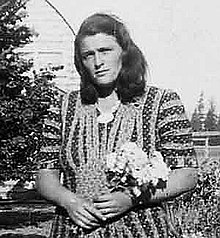Martina Gangle Curl
Martina Gangle Curl | |
|---|---|
 | |
| Born | December 21, 1906 |
| Died | February 20, 1994 (aged 87) |
| Education | Pacific Northwest College of Art |
| Known for | printmaking, painting, sculpting |
| Movement | Modernism |
Martina Gangle Curl (December 21, 1906 – February 20, 1994) was an American artist and activist. Her murals, prints, and social activism highlighted labor rights in the United States.
Early life and education[edit]
Martina Gangle Curl, born December 1906 in Woodland, Washington, was one of seven children. Born into a migrant family of Austrian and Swedish descent, Curl grew up in poverty and began work as a fruit-picker at the age of eight.[1] She attended a small country school until 1920, when she moved to the Lents district of southeast Portland to live with her grandmother.[2] While living with her grandmother she attended Franklin High School where she excelled in math and physics.[1] During her high school career Curl worked part-time as a housekeeper for a local family, who encouraged her to expand her knowledge through literature. Martina started to keep a dictionary which she used to look up unfamiliar words, and avidly read Charles Dickens and Greek dramas. After Curl graduated in 1924, she received a $200 loan from her employer to use towards her education.[1] She spent a year teaching at Western Oregon University (formerly the Oregon Normal School), and afterwards worked as an elementary school instructor in Portland.[2]
Curl stopped teaching in 1926 after giving birth to her son, David, and the father abandoned them shortly after.[1] Desperate for money, Curl spent the next four years working at a boarding house in southeast Portland.[2] She received $35 a month and a bed on the back porch for herself and her baby. In 1931, she used what little savings she had accumulated plus a personal loan to enroll in the Museum Art School.[1]
When Curl started attending the University, she found herself unable to relate to her peers. While she grew up in a working-class family, many of her classmates came from upper-class backgrounds. However, she found solace from her professor and fellow painter Harry Wentz. He encouraged her to paint more expressively, and helped her receive a two-year scholarship to complete college.[1]
While in college, Curl became more aware of the wide class differences between her and her more affluent classmates. Within her first year attending the school, she came across a group of demonstrators. They gave her a pamphlet recruiting people for the communist party and introduced her to the idea of socialism.[1] As an impoverished art student living in the era of the Great Depression, Curl hoped socialism would allow her to make a living in the vocation she loved. By 1936 she joined the communist party, and applied for a position with the Federal Arts Project which started her professional artistic career.[2]
Career[edit]
Curl gained a reputation for her social activism.[3] She was arrested several times throughout her life, as she often partook in protests and demonstrations which landed her in jail.[4] By the late 1930s her artwork became increasingly focused on her political views.[2] She advocated for workers rights, and believed socialism bridged the gap between the Christian ideals she had been taught as a child and the reality of capitalism.[5]
Artworks[edit]
Known for her modernist approach to art, Curl often made prints using a western woodcut style.[5] Her work received a mixed reception. While she gained fame in the late 1930s due to her association with other artists and activists, she believed her radicalism prevented her from attaining more mainstream success.[1] Her art usually reflected the daily life of the working class, women, and life in migrant camps.[5]
Major exhibitions[edit]
Oregon Art Guild exhibition in 1948.[2]
Public collections[edit]
- Portland Art Museum
- Oregon Historical Society
- Timberline Lodge
- University of Oregon
- Oregon Society of Artists
- Museum of People's Art
- Hallie Ford Museum[5][6]
References[edit]
- ^ a b c d e f g h David, Horowitz (2004). "Martina Gangle Curl (1906-1994): Peoples Art and the Mothering of Humanity". Oregon Cultural Heritage Commission.
- ^ a b c d e f Humpal, Mark (March 17, 2018). "Martina Gangle Curl (1906 - 1994)". The Oregon Encyclopedia.
- ^ "Martina Gangle Curl Obituary". The Oregonian. February 23, 1994.
- ^ Polishuk, Sandy. Sticking to the Union: An Oral History of the Life and Times of Julia Ruuttila. Palgrave Macmillon.
- ^ a b c d "Oregon Art from the WPA Era: Martina Gangle Curl". The Pathways Collection.
- ^ Cowan, Ron. "Mid-Valley Arts. 'Artist's conversation' to remember Heaney". Statesman Journal. Salem, Oregon. p. 8D. Retrieved 30 July 2019.
